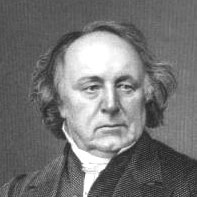- Thomas Binney
Infobox Person
name = Thomas Binney

image_size = 175px
caption =
birth_date =
birth_place =
death_date =
death_place =
education =
occupation =
religion =Christian (Congregationalist)
spouse =
parents =
children =
nationality = BritishThe Rev. Dr. Thomas Binney (1798-1874) was an English Congregationalist divine of the 19th century, popularly known as the 'Archbishop of Nonconformity'. He was noted for sermons and writings in defence of the principles of Nonconformity, for devotional verse, and for involvement in the cause of anti-slavery.
Binney was born of
Presbyterian parents atNewcastle-on-Tyne in 1798, and educated at an ordinary day school. After spending seven years in the employment of a bookseller he entered thetheological school at Wymondley, Herts, later incorporated in New College, Hampstead.In 1829, after short pastorates at
Bedford (New Meeting) andNewport, Isle of Wight , he accepted a call to the historicKing's Weigh House Chapel,London in succession to the elder John Clayton. Here he became very popular, and it was found necessary to build a much larger chapel on Fish Street Hill, to which the congregation removed. Its eminent members included Samuel Morley MP.Thomas Binney laid the foundation stone of the new chapel himself, in 1834. An address delivered on the occasion of the laying of the foundation stone, published with an appendix containing a strong attack on the influence of the
Church of England , gave rise to a long and bitter controversy. Throughout his career Binney was a vigorous opponent of the state church principle, though he maintained friendly relations with many of the dignitaries of the Established Church. His liberality of view and breadth of ecclesiastical sympathy entitle him to rank, on questions of Nonconformity, among the most distinguished of the school ofRichard Baxter . Indeed, he became known as 'the Archbishop of Nonconformity'.Thomas Binney was an active member of the British and Foreign Anti-slavery Society formed in 1839, which became "Anti-Slavery International" in 1990. A painting at the National Portrait Gallery in
London shows " [http://www.npg.org.uk/live/search/portrait.asp?search=ss&LinkID=mp00422 'The 1840 Anti-slavery Convention] " (the first World Anti-slavery Convention) identifying many of its key participants, withThomas Clarkson introducing the event chaired by the Rev. Thomas Binney. In 1853, when the African-American abolitionistSamuel Ringgold Ward came to Britain to raise funds for the "Anti-slavery Society of Canada", a time when there was a vast influx of escaped slaves from the United States seeking refuge in the British colony, he brought letters of introduction to Thomas Binney, planning to seek help initially from fellow Congregationalist's in London such as Binney, James Sherman and Josiah Conder. Thomas Binney later became the biographer of Sir Thomas Fowell Buxton, a leading parliamentaryabolitionist .He continued to discharge the duties of the ministry until 1869, when he resigned. In 1845 he paid a visit to
Canada and theUnited States , and in 1857-1859 to theAustralia n colonies. TheUniversity of Aberdeen conferred the LL.D. degree on him in 1852, and he was twice chairman of the Congregational Union of England andWales .Binney pioneered changes to the forms of service in Nonconformist churches, and gave a special impulse to congregational psalmody by the publication of a book entitled "The Service of Song in the House of the Lord". Of numerous other works the best-known is his "Is it Possible to Make the Best of Both Worlds?", an expansion of a lecture delivered to young men in Exeter Hall, which attained a circulation of 30,000 copies within a year of its publication. He wrote much devotional verse, including the well-known hymn "Eternal Light! Eternal Light!"
Binney preached his last sermon in November 1873. After some months of suffering, he died on 24 February 1874. Dean Stanley assisted at his funeral service in
Abney Park Cemetery ,Stoke Newington , London, where today his monument, a tall pink granite obelisk, can still be seen near to that ofWilliam Booth , close to Church Street.Books
* Binney, Thomas (1831) 'A study for young men or A Sketch of Sir Thomas Fowell Buxton', Boston: Crosby & NicholsExternal links
* [http://www.npg.org.uk/live/search/portrait.asp?search=sp&sText=Anti%2DSlavery+Society&rNo=0 Anti-Slavery Society Convention 1840]References
* Obituary in the Congregational Year Book 1875 pp.313-317
----
*1911
Wikimedia Foundation. 2010.
